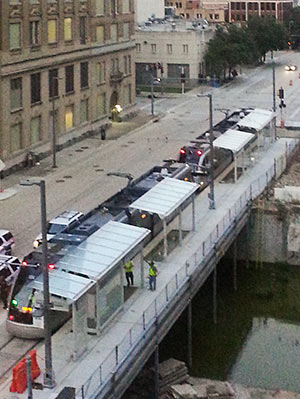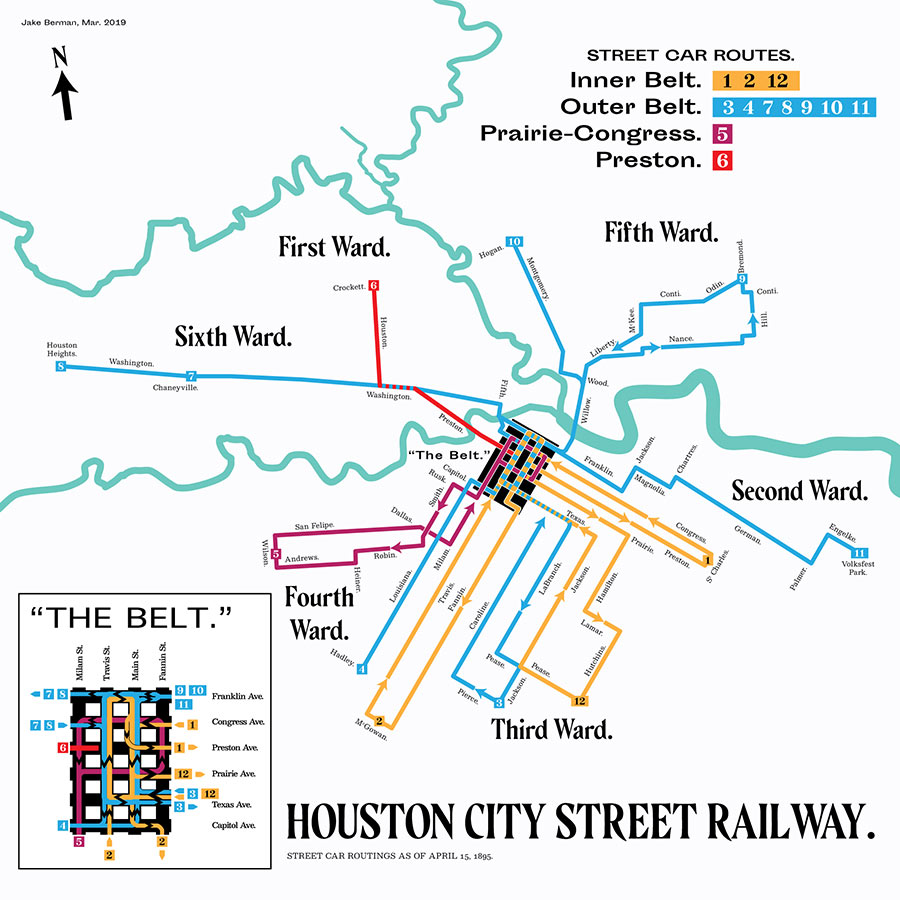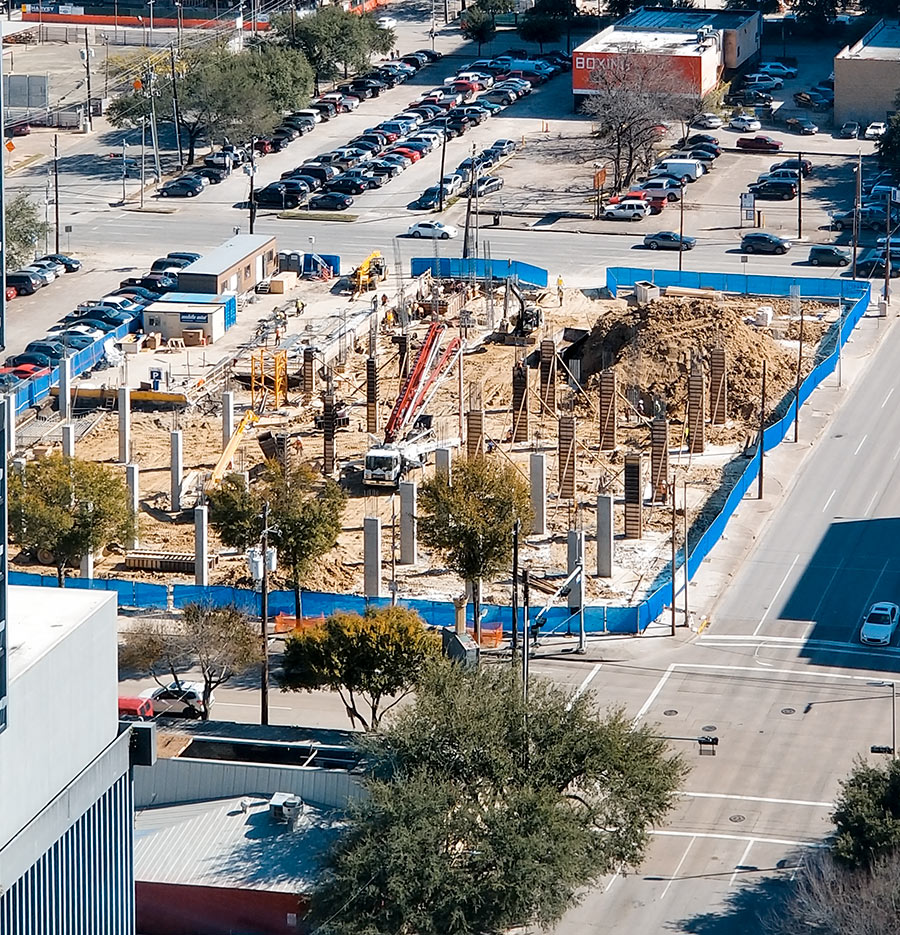 No, no one’s expecting Metro’s 2 new light-rail lines to open any sooner than late December (as Swamplot reported last week), but some progress toward that goal is now visible on portions of the East End and Southeast lines: “Live wire” or powered testing of the downtown tracks began this week. The photo at right, sent in by a reader, shows a Metro train moving unescorted along the tracks on Capitol St. for the first time.
No, no one’s expecting Metro’s 2 new light-rail lines to open any sooner than late December (as Swamplot reported last week), but some progress toward that goal is now visible on portions of the East End and Southeast lines: “Live wire” or powered testing of the downtown tracks began this week. The photo at right, sent in by a reader, shows a Metro train moving unescorted along the tracks on Capitol St. for the first time.
- Southeast and East End Line coverage [Swamplot]
Photo: Nathan Juett
Power Up





Sooner, hopefully, rather than later the whole city realizes the economic & social benefits of a light rail connection between the Galleria-area, downtown, and IAH/HOU airports.
Interesting. I can’t think of a single reason where the light rail between those areas has any benefit whatsoever.
To go from Galleria to Downtown? NO. Nobody lives at the galleria so you still have to drive to the train and park, which makes it a glorified Park & Ride which already exists.
To go to airport? NO. Why would I lug my luggage around on trains and having to switch trains. Just catch a cab or do what everybody in Houston does and get a ride from friend/relative.
To go shopping? NO. nobody can carry enough stuff to make it last, so you would have to shop pretty much every day.
I have to agree with Commonsense here. They claim that Metro’s Light Rail has been designed to maximize ridership, but I really question that. They have completely cut the entire Gulfton neighborhood out of their plans from day one. It’s our City’s densest residential neighborhood and it’s demographics make it’s existing transit routes some of the busiest in the system. Sharpstown and Brays Oaks also have incredibly high bus ridership numbers and are not a part of any current Metro Light Rail plans either.
.
It might be more accurate to say Metro wants to maximize wealthy White Collar ridership on its light rail system. Not so much ridership in general.
Light rail to airports would be a godsend. Currently, Supershuttle—usually, but not always reliable—is the cheapest option at $25-30 per ride in a shared-ride van. A cab will cost up to twice that. Taking a car, supposing that you have one and that you don’t have a family that needs it while you’re gone, means that you’ll pay for parking. And all of those options may or may not be impeded by city and highway traffic.
Light rail would likely be slower than any of these, but significantly cheaper, and I’m always able to get work done on trains.
… They’re building a Light Rail system that’s meant to cater to upper middle class 20 and 30 something’s who live Inside the Loop and work either Downtown or in the Med Center.
I’m so happy to see the rail finally expanding within Houston. As a native Houstonian who has lived in other cities (New York, Washington, D.C.) and abroad (London, Paris), I’ve experienced the ease and convenience of the subways and trains. There are many naysayers in Houston now, but as a city which prides itself in being so expansive, one would think Houston would have incorporated a train system into that plan decades ago. I laugh when I read comments saying there is no reason for the train system. Many, many years ago, I bought my mother her very first microwave, and she swore up and down she would never use it. Now, she hardly makes anything, even tea, without it. I wager all those who can’t see the use of the train currently will get on at some point, and find themselves using it more and more. I welcome the train system.
Agreed.
.
I was reading through one of metro’s fiscal reports about two years ago or so and they admitted that they were running a good chunk of the bus routes at a net loss if it weren’t for the federal government dumping money into the metro system to provide buses to “undeserved areas” or some other nonsense. These are places where even many people under the poverty line have automobiles.
.
So we already pay 1 cent or so sales tax to go to metro, then the federal government takes money out of our paychecks to send it back to metro to drive around “poor” parts of town with empty buses for nebulous and ill defined objectives somehow related to “social justice.” All while on the other that very same federal government harps about us lower and middle class peasants producing too much CO2. I guarantee you the empty buses you’re driving around produce a lot more than my little compact car. Additionally the money metro gets from bus fares from people that actually want to use their service is a minority of their income.
.
Lets take some back of the envelope math from their FY2013 Business Plan. (Page 55)
Fares: $65 million. Sales tax: 614 million. Grants: 125 million. Other: 5 million. Borrowing: 75 million (not included in next calculation.) So total fares are about 8% of Metro’s revenue. So for every $1you spend in fares it costs the taxpayer $11.50. So a $5 fare trip costs metro $62. A $10 fare costs comes out to $125.
.
Enjoy your metro limousine ride.
.
(Note: There is a good chunk of caveats and other things needed to be fair to metro. This comment is a direct, clear and concise, as the internet requires, but I regret needing to sound harsh. For example about 1/4 of its sales tax is earmarked for road maintenance. They fund the transtar system and metro police (even though why they need that aside from HPD and Harris Co Sherrif isn’t clear) which of course generates no revenue. A comment isn’t the place for all the required caveats. Fortunately if you want the real details their reports are relatively clear and easy to read.)
On-grade is a huge mistake and we keep building more of it taking away the road lanes. We need both car lanes and rail Whittling down the lanes on Post Oak will be a disaster. Rail should be fast but our version effects traffic and takes forever to get anywhere.
I also agree with the comments about catering to the 20-30 somethings rather than increasing ridership.
As soon as I saw light rail mentioned in the headline, I didn’t even have to read the comments to know what they would be, who would write them, and how they would fall out.
Pro-rail gloating against anti-rail diatribes. This is a great way for Gus to generate chatter and traffic – throw a light rail post out there once a week and watch the water froth in the frenzy.
swamplot serves as a nice alternative for banter on infrastructure issues significant to civic life as opposed to chron.com where hearst force feeds a superfluous dumbing-down on an embarrassingly prominent level for the very reasons, superdave, you describe.
@ZAW: For your comment to be true, the East End and Southeast sides will need to convert to white-collar residential pretty soon. They may do that, but for now you can hardly claim that those new lines will be serving white-collar folks. It’s more like they were a sop to certain constituencies in order to gain certain elected officials’ support.
FYI to everyone: While at-grade definitely has some drawbacks, the new lines are not necessarily taking away lanes everywhere. Scott, MLK, and Post Oak will have the same number of lanes. What is disappearing, especially on the light rail routes, are left turn openings, a feature which does have some negative consequences.
That said, I support implementing exclusive-lane BRT across the west side of the Inner Loop, with its large amount of denser mixed-use and intra-city travel, with or without full general-purpose lane replacement. It’s not a train so anti-train folks won’t be upset. Maybe extend to the southwest side to get ZAW’s satisfaction, as if he/she was going to use it.
Swamplot posts articles and generates discussion. That’s the point, Superdave.
Local Planner: I agree BRT seems the most reasonable for north-south transit within the Galleria-area. But for connecting already established urban densities and destination points (e.g., downtown, TMC, Greenway Plaza, Galleria, the major airports), the permanence of light rail gives the necessary right-of-way and transit regularity for people to move in & out of those sites. As the region continues to densify and the burden of vehicle congestion grows beyond palpably nightmarish, perhaps then anti-rail theologists won’t need to actually conceptualize that transit pragmatism offered by rail (light rail & commuter rail to the suburbs) defeats their soapbox stance against its initial cost. Either through infrastructure short-sightedness or as an extension of their general feelings against all things government, anti-rail folks also refuse to see that rail becomes an advocate for the area to continue thriving economically.
As Metro’s rail network grows, usage of individual lines complement all the other lines as riders realize the benefits of cross-town rail transit versus car commuting. Commercial development along rail nodes to the suburbs give ample opportunity for the investment community and not only furthers rail de-stigmatization but also lessens all the deleterious impacts of vehicle dependency.
If Texas Central Railway, the private bullet train company, succeeds in its plans to fast-connect Houston with Dallas, I hope local planners make the obvious case for stops in the Woodlands and IAH before terminating in a downtown location that connects to Metro’s light rail lines. This would be a great chance to serve as commuter rail connecting downtown with the north suburb & airport.
Oh please, Planner. Everyone knows that EADO is next in line to turn now that Midtown and Montrose have fully gentrified, and the Washington Avenue corridor is finishing up. Even if the area isn’t wealthy and white collar now, it will be in a decade or less. The people at Metro are surely aware of it, too.
.
As far as BRT. To METRO’s credit, they did build enhanced bus service to the northern portion of Sharpstown and Gulfton. (Not sure if the Quickline really qualifies as BRT, either way it’s definitely not Light Rail). But Brays Oaks doesn’t even have that – even though the 163 bus’ ridership rivals that of 2/402. And forgive me, but that 90/A commuter line they talk about just seems enigmatic. I see a lot of promises and grand plans, but I don’t recall seeing any funding or a timeline for it.
@tony – Well put.
Of course a large part of Metro’s design of these lines has to do with spuring on development, that is pretty obvious. Light Rail has been very successful in helping transform Midtown and no doubt Metro is hoping that success continues on its new lines. ZAW has a point about Metro’s motives and they’re interesting selection process in relation to exactly where these lines are developed, however it’s a bit simplistic to say these lines are only going into affluent areas and that they’re exclusively designed to cater to successful 20 and 30somethings. Last time I looked Harrisburg wasn’t Post Oak or Montrose and it’s not going to be anytime soon. As for nobody using light rail to go to the airport someday, that’s just nonsense of course people would use it. People would also hop on it of it went to the Galleria. Light rail opponents are so strident in their opposition that they refuse to accept that anyone actually rides these trains. I ride the main line all the time and I’d most certainly ride one out to the Galleria, I highly doubt my bag from Armani Exchange would be so cumbersome that I couldn’t get it on the train
@ZAW: Not sure why you bring up Washington Avenue, any rail line there is currently less of possibility than the University Line. And EaDo, at least the gentrifying part, is just one stop on the new lines at present; Leeland Station on the Purple Line will eventually get there, though you’ve got a large dairy next to the station that has been subsidized by the City to stay put. After those two stations, gentrification on that line is more delayed. Same thing on the Green Line for the stations east of Coffee Plant. The north extension of the Red Line is actually poised for gentrification in the near term, being next to the Heights, 1st Ward and Downtown. As long as Houston’s economy keeps growing at a reasonably strong pace, gentrification should arrive at some point, but for the most part the new lines are serving areas that are dominated by low-mod income blue collar and service workers, mostly non-Anglo.
All that said, I would say that real success of these new lines does hinge upon both gentrification and densification. Gentrification because the lines are designed to get downtown, a primarily white collar employment center, and the current population in the served areas isn’t the labor pool for those jobs. Densification because these areas are essentially low-density, which is counter to conventional wisdom for rail transit; METRO needs densification to provide ridership to make the investment worthwhile (at least the Purple Line has UH which will provide some built-in ridership).
@Shannon, an occasional or obscure reason to ride the rail does not justify it’s existence. For it to make sense you need commuter volume, which can’t happen because the rail does not go from living centers to work centers.
—
P.S. 90’s club scene called and want their Armani Exchange style back. :)
What I’m saying Planner, is that it’s not just density that METRO wants on it’s light rail routes. It’s money AND density. You can have over 14,000 people per square mile (Gulfon does) – if they’re not rich, you won’t get light rail from METRO.
FWIW, METRO’s University Line plans do show a station at Renwick, which is presumably intended to serve the Gulfton community.